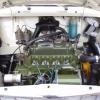I have never seen any great accuracy in any dynamo systems, and my most recent certainly went well over 15 volts on occasion. I don't envisage ever having another, as I prefer reliability to originality, but I would agree that rare old models should be kept original, and should be well looked after. Just not for me, because I would want to do high mileage.
If you have set it to 14.2V maximum, you may find that it does not replenish the battery adequately when you have lights etc on. That is why they were usually set a bit high. Alternators are generally set at 14.4V. Battery chargers often go much higher, 17 to 18 volts is not uncommon. The difference is that the current tails off at high voltage with both dynamo and battery charger, while an alternator will deliver its rated current right up to the preset voltage, if there is any load to absorb it, so it has to be more tightly controlled.
Current compensated control, with three "relays" in the regulator box, instead of 2, was very much better, but not used on Minis as far as I can tell. My old Rover P4 had that, and the regulator was temperature compensated too. Sadly the regulator was under the bonnet and the battey under the back seat, so the temperature compensation was probably all but useless, but it did give somewhat higher voltage as the current demand rose, without going above 14V on light load. Not as good as an alternator, because you did need some revs to get a decent rate of charge, but I never did get a flat battery with that one.
But if you are happy with it, just run it and see what happens. If necessary, adjust slightly if the battery does start to get a bit low. It will probably droop at very high revs, especially when the dynamo is hot.
Oh, and I will bear in mind your point about calcium batteries. They might not reach full charge in an alternator system if that is correct, but 99% is good enough.
Edited by tiger99, 01 April 2012 - 04:22 PM.















